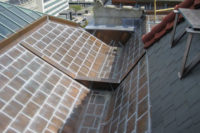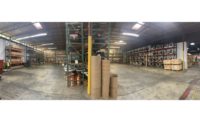In the previous issue, we discussed material selection and quality control measures to improve the quality of soldered architectural sheet metal joints and minimize vulnerability to failure due to thermal movement and water infiltration. In this issue, we will discuss the procedure and quality control measures for joint preparation and soldering techniques that must be implemented to avoid soldered architectural sheet metal joints that are vulnerable to failure. Photo numbering follows from our previous article, and begins with Photo 3 in this article.
Construction of durable and watertight soldered sheet metal joints is difficult to achieve in a field environment where dust, dirt, debris and other contaminants can limit the effectiveness and quality of the soldered joint. Although proper material and equipment selection is crucial in preparation for soldering architectural sheet metal, detailed forming, cleaning, and soldering techniques are also necessary to ensure durable and watertight soldered joints.
Base Metal Forming
Proper forming techniques begin with cutting and folding of the base metals. If the sheet metal components do not have straight and crisp cuts and folds, the joints between the sections of metal cannot be “dressed” tight to one another, which may inhibit flow of the solder into the joint. Where feasible, perform the majority of any sheet metal cutting and forming operation on a shear and bending brake, respectively. Limit hand shaping, trimming and seaming in the field as much as practicable, and ensure that any field work is performed with proper sheet metal hand tools. Form flat lock seams with ½ to ¾-inch legs on the seams.3,4 Initially, leave bends in base material under-bent (partially open) to permit proper cleaning and pre-tinning of joint interior surfaces. Pre-drill any joints to be riveted prior to cleaning the sheet metal to avoid metal shavings remaining within the joint that could inhibit uniform solder flow.
Cleaning
Clean the sheet metal base material immediately prior to pre-tinning and joining sections. Wipe all surfaces to receive solder with a clean, dry rag and use a wire brush, wire wool, or emery cloth to mechanically remove embedded contaminants and oxidation from the base material. Apply flux to all desired surfaces of the joint prior to pre-tinning, applying flux only where solder will be placed. Properly cleaned and fluxed metal surfaces will be bright and shiny in comparison to the surrounding surfaces that have not been cleaned (Photo 3).
The soldering iron must also be cleaned immediately prior to commencement of soldering. Once the soldering iron(s) are heated, use a wire brush and file to remove oxidation and previous solder remnants from the tip (bit). Rub all surfaces of the soldering iron tip on a block of Sal Ammoniac (ammonium chloride), and dip the tip of the iron in a container with a water and flux mixture (3:1 ratio) to complete the soldering iron cleaning procedure. Repeat this procedure as required during the soldering process to maintain a clean soldering iron tip.
Pre-Tinning and Heat Control
The soldering iron and base sheet metal should be pre-tinned prior to soldering to facilitate solder flow and promote bond of the solder to the desired surfaces. To pre-tin the soldering iron, melt a small amount of solder on the block of ammonium chloride and rub the soldering iron tip surfaces over the solder so that a thin layer of solder remains on all parts of the tip to be used. Avoid pre-tinning the downward facing horizontal surfaces of an iron when used to solder vertical joints in place, to prevent solder from flowing readily down and off of the bottom of the iron.
Once the iron is pre-tinned, heat the sheet metal individual sections at the respective common joint surfaces, applying the same type of solder that was used to pre-tin the iron near the soldering iron tip, forming a small puddle of liquid solder on the sheet metal. Drag the tip of the iron in one direction along the metal adding solder as necessary, so that a thin layer of solder remains on the desired surfaces of the sheet metal sections that will form the joint. Apply only as much heat to the base metal as necessary to melt the solder. If too much heat is applied to the base metal, the metal may warp or oxidize, which will prevent bonding of solder to the base metal, and will require additional mechanical cleaning and fluxing to remove the oxidation prior to re-soldering.
Dressing
Once the sheet metal components have been pre-tinned, install the sheet metal in its final location. Seams must be hammered down flat and tight so that all surfaces within the joint are in contact within one another. If any voids exist within the concealed joint, capillary solder flow will not be achieved through the joint. Sheet metal in riveted joints must be installed flat and tight together and with rivets hammered down tight to the joint so that all surfaces of the lap are in contact with each other. Once the sheet metal section is in place, mechanically clean and apply flux to all surfaces adjacent to the joint to receive solder, or a minimum of ¾ inches each way from the visible edge of the joint (Photo 3) (and across the full width of a riveted joint).
Prior to soldering, the joint should be tight and clean, with no oxidation or surface contamination to impair the flow and bond of the solder to the base metal. The base metal sections must be straight and joints hammered crisp with no buckling, creasing, or other defects that leave large gaps between the surfaces to be soldered. If a joint cannot be hammered flat or exhibits large gaps along its length, the base metal sections must be altered to allow for a tight section-to-section fit and a tightly-soldered joint.
Soldering
Begin soldering (again, using the same type solder used to pre-tin the metal) by applying heat and solder to the joint, moving the soldering iron in one direction while filling the joint completely with solder. Place the thick part of the soldering iron on the “high-side” of the sheet metal joint with the tip extending over the joint approximately ¾ inches and apply solder to the base metal on the low side of the joint (Photo 4). Apply solder frequently to maintain a small liquid puddle of solder near the tip of the soldering iron on the low side of the joint. Slowly drag the iron along the joint, heating the sheet metal evenly, and adding solder as necessary to fill the joint; the heat will cause the solder to “sweat” (or be drawn) into the joint through capillary action.
If the iron is moved too quickly along the joint, the solder will cool quickly, which will limit its flow into the joint. In this case, the solidified solder will appear uneven or wavy, will tend to pile on top of the joint, and will solidify in puddles with rounded edges at the edge of the joint. When heated and applied at the proper rate and temperature, the solidified solder will have a smooth and shiny appearance, will appear to blend with the base sheet metal beyond the joint, and will not appear concave or contain discontinuities at the lap between pieces of metal (Photo 5). It is also critical to control the heat of the iron during soldering to prevent overheating that can lead to warping and/or oxidation of the sheet metal (Photo 6).
At vertical sheet metal joints or when required for aesthetic considerations, the joints should also be laced. Lacing involves using the edge between two surfaces of the soldering iron tip to drag additional solder across the solder joint. This process leaves intentional evenly spaced ridges or ripples along the joint that can strengthen the joint in the transverse direction (Photo 7).
Inspection
Inspection of soldered joints can be performed by both destructive and non-destructive methods. Destructive inspection of the joints is conducted by cutting the sheet metal joint in the transverse direction to observe the cross section of the solder within the joint. While this method provides a clear indication of whether or not the joint is filled with solder, it obviously cannot be used to evaluate finished or in-place work. A properly soldered joint will exhibit solder completely filling the space, without voids, in the lock joint (Photo 8). If the base metal was significantly colder than required during soldering, the solder will not adhere to the base metal even where it appears to be in contact, and these joints can be pried apart; such joints will fail in service in a short amount of time.
Perform destructive inspection methods on samples created during mockups or soldering qualification testing of sheet metal workers to establish the standards for soldering quality prior to beginning sheet metal installation. Qualification testing requirements typically involve soldering and destructive inspection of soldering samples of each type of joint for each sheet metal mechanic who will be soldering on a particular project. Destructive inspection may also be used when non-destructive inspection observations repeatedly indicate questionable quality of the finished product in an assembly that requires durable and watertight soldered joints.
Non-destructive inspection methods should be used as routine self-inspections performed by sheet metal mechanics throughout the process of forming, cleaning and soldering architectural sheet metal as previously described. Architects, engineers, inspectors, foremen, general contractors, or any other third party inspectors should be looking for the same key elements as the installers, as described above. A note of caution: completed soldered joints may appear to be well installed, and yet be very poorly sweated. Non-destructive testing alone is not an acceptable alternative to destructive testing. Both methods must be utilized as a part of a comprehensive quality control program to ensure a successful project.
Cleanup
Once soldering operations at a particular area are complete, the soldered joints must be cleaned before the flux and or other contaminants are permitted to dry on the surface of the sheet metal; this will prevent staining or discoloration of the base metal, and will remove any remaining dirt to facilitate final inspection of the completed joint. Apply a baking soda or mild soap and water mixture to the joint to neutralize acid-based fluxes, and clean any remaining contaminants from the soldered joint. Scrub the joint with a soft bristle brush, rinse with clean water, and wipe the joint with a clean rag. If any voids or deficiencies are observed during final inspection, the deficient areas must be cleaned with flux and re-soldered if the joint has not weathered (i.e., if the defects are identified immediately after soldering); otherwise, the work must be removed and replaced if the joint becomes weathered and contaminated, followed by an additional thorough cleaning and inspection. If corrosive or environmentally unfriendly base metals or fluxes are used, collect and properly dispose of runoff from the cleaning procedure as required.
Summary
Since the durability and watertight integrity of a soldered joint is dependent on the continuity and bond of the solder within the sheet metal joints, rigorous quality control measures for proper material selection, joint preparation and soldering techniques must be implemented to avoid joints that are vulnerable to thermal movement and water infiltration.
Soldering of architectural sheet metal components involves thorough planning, attention to detail, and implementation of proper installation techniques to provide durable and reliable watertight assemblies. Material selection, joint preparation, and workmanship are critical components of producing quality soldered architectural sheet metal joints. Due to the range of considerations that impact the quality of a soldered sheet metal joint, and the level of craftsmanship required to repeatedly install properly soldered joints (including pre-qualification and testing of mechanics), the ability to identify and correct poorly soldered sheet metal joints in the field is a crucial component of any soldering quality control program. All of these components can only be specified, learned, and taught through experience and practice of the various steps outlined above.
References:
3. Copper & Common Sense: Sheet Copper Design Principles and Construction Techniques (7th ed.). (2000). Rome, N.Y.: Revere Copper Products.
4. Architectural Sheet Metal Manual. (2012). Sheet Metal & Air Conditioning.










